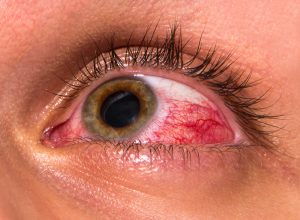Around 1 in 50 Europeans over the age of 40 and 1 in 10 people over the age of 75 have chronic open-angle glaucoma. The term ‘glaucoma’ actually refers to a collection of diseases that cause optic nerve damage.
Glaucoma can occur for a variety of reasons, yet any optometrist knows that the condition can be managed or even prevented by following a healthy diet consisting of dark skinned fruits and green leafy vegetables (to ensure they get maximum amounts of Lutein and Zeaxanthin) along with various vitamins and minerals.
One recent study published in JAMA Ophthalmology, took to examining the possible relationship between nutrition and glaucoma. The study went to investigate the 3,865 people in the National Health and Nutrition Examination Survey (NHANES) 2005-2008 database. Those aged 40 or older participated in the dietary intake and vision health questionnaire of this cross-sectional study.
The Study’s Details and Findings Support The Case For Good Nutrition
Results of the study showed those participants taking higher daily quantities of eicosapentaenoic acid (EPA) and docosahexaenoic acid (DHA) were determined to have a lower likelihood of having glaucoma.
The study looked at daily dietary polyunsaturated fatty acids (PUFAs) intake to determine its potential relationship to the prevalence of glaucoma in the study participants. Study inclusion was predicated upon the availability of the laboratory test results, along with frequency-doubling technology (FDT) visual field loss detection tests, and optic disc photographs.
Omega-3 fatty acids EPA and DHA are most commonly found in supplements and food sources such as oily fish like mackerel, sardines, etc. Those participants taking higher quantities of “total” PUFAs were determined to have a higher likelihood of being diagnosed with glaucoma. Researchers suggest this finding may be due to the relative ratios of Omega-6 and Omega-3 fatty acid intake.
Further Inquiry Into Glaucoma Risk Needed
While more studies may be needed, clinicians note that nutrition is one of the only risk factors they can work with. Age, family history and race are not modifiable. Investigators now need to undertake other longitudinal studies in order to repeat and verify the relationship between glaucoma and nutrition.
The study does provide further evidence to support the relationship between omega-3 fatty acid supplements and how they can benefit and improve eye health conditions such as glaucoma.
Glaucoma Symptoms And Causes

Symptoms
Some of the most common symptoms of glaucoma include reduced peripheral vision, intraocular pressure (IOP) greater than 21, or where there is a large discrepancy in IOPs between the two eyes. Optic cup asymmetry can also contribute to the condition.
Causes
- High Level of Stress – Results in poor breathing and digestion and comfort eating of starchy foods.
- Bad Diet – Too many starchy foods like bread, pastry, biscuits, breakfast cereals, and high starch root vegetables (potatoes, parsnips, etc.). These all cause a damaging high level of glucose spikes in the bloodstream.
- Nutritional Deficiencies – Often sufferers of glaucoma are deficient in some or many of the important nutrients, including essential fatty acids, Lutein, zeaxanthin, Taurine, antioxidants, bioflavonoid, zinc, selenium, and vitamin B complex.
- Drugs (Most All Prescribed Drugs) – Use of any prescribed drugs will have some side effect; for example, antibiotics are a prime culprit in poor digestion due to the killing of important stomach flora. This will inhibit Taurine as an important amino acid in the eye.
- Family History of Glaucoma – Can be genetic or just simply living the same lifestyle.
- Other Chronic Diseases that can raise IOPs include obesity, diabetes, cardiovascular disease (insufficient blood flow to the eyes), and thyroid disease (hyperthyroidism). These diseases are in the main caused by 1, 2, and 3.
- Being African-American – Glaucoma is the leading cause of blindness among this population. This racial grouping is known to be unable to eat high starch food groups—again, in the main caused by 1, 2, and 3.
- Extreme Nearsightedness or Farsightedness – At a higher level and a risk of angle closure. 1, 2, and 3 may cause this also.
- Steroid Use – Often in the form of eye drops, nose drops, or inhalants (elevates IOL pressure mildly in approximately 16% of people on steroids).
Different Types of Glaucoma
Here are the various types of glaucoma and how their symptoms and causes can be treated. Follow the Glaucoma Health Plan for best results in finding relief, alongside the advice below…
- Open angle or chronic glaucoma is the most common type. It responds well to nutritional intervention and following a good eye health plan.
- Narrow angle glaucoma is considered an ocular emergency. Symptoms can occur suddenly and include painful red eye nausea, headaches, nausea and visual halos. Seeking immediate medical help is highly recommended in those cases.
- Low Tension Glaucoma is usually a sign of poor circulation. Heart problems, brain tumors, or toxic drugs can all produce optic nerve damage that may present as glaucoma. Natural Health Doctors are recommended for diagnosis and appropriate treatment.
- Secondary Glaucoma can develop secondarily to other conditions, due to inflammation, injury, blood in the eye, or drug side effects (such as from steroids). A Natural Health Doctor is recommended for diagnosis and appropriate treatment.
- Glaucoma Suspects are people with higher than normal eye pressure but who never develop glaucoma. These people should be monitored regularly. They often respond well to nutritional intervention as per our recommendations.
- Congenital Glaucoma may occur in the first few months of life. A Natural Health Doctor is recommended for diagnosis and appropriate treatment.
Take Omega 3 and 6 Oils To Support Good Eye Health

As the above study demonstrates, it’s essential to take care of your eye health with the right nutrients. Taking a Krill Oil supplement (alongside your food sources of Omega 3, 6 and 9) is highly recommended.
EPA and DHA are both important types of Omega-3 fatty acids that can support various actions and functions within the body. EPA (eicosapentaenoic acid) and DHA (docosahexaenoic acid) are long-chain fatty acids found in fish and shellfish. Algae is another good source of DHA.
These Omega oils can support the protection of cell membranes, while stabilising blood sugar levels in the process. A number of clinical studies have shown that Omega-3 fatty acids are essential for normal infant vision development, indicating they play an essential role in good eye health.
Recommended Examples
 The Krill Miracle™ – Contains Omega 3, 6 and 9 oils to support the body’s natural anti-inflammatory processes and promote good eye health. Krill oil is rich in EPA and DHA and is safe, pure and free of heavy metals, PCBs, dioxins, and contaminates. The Krill Miracle™ – Contains Omega 3, 6 and 9 oils to support the body’s natural anti-inflammatory processes and promote good eye health. Krill oil is rich in EPA and DHA and is safe, pure and free of heavy metals, PCBs, dioxins, and contaminates.
Made from Krill, a tiny shrimp-like crustacean found in the Southern Oceans. The Southern Oceans are the only oceans in the world that remain unpolluted by the heavy toxic metals that are now to be found in many fish oils. Krill are a super rich source of Omega 3, 6 & 9.As a vegetarian alternative, consider Hemp Seed Oil or Flaxseed Oil to receive the health benefits. Available from Good Health Naturally. |






Some with normal or low IOP develop glaucoma. Some with very high IOP never develop glaucoma. Similarly, normal or low cholesterol patients present with heart attack just as often as those with high cholesterol do. Just as high cholesterol is chosen to fit the current paradigm of heart disease / attack, is it possible that high IOP is chosen to be the primary cause of glaucoma when in reality, it’s reported only when high?